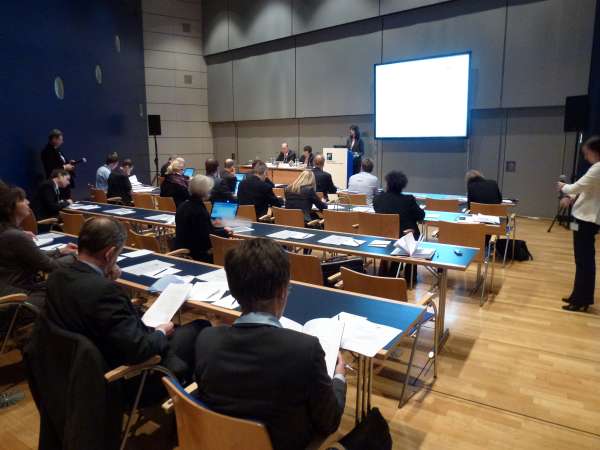COMMENT
 So close yet so far away is probably the best way to describe the state of Solvency II today. In this article, Gideon Benari, Editor, Solvency II Wire, looks at the whys and hows and the big headache it’s giving EIOPA.
Unusual times
This year’s EIOPA conference was abuzz with talk of partial implementation of Solvency II. The delay itself seems to have been taken as a given. The big question on everyone’s mind was, what will happen until then?
These are unusual times, requiring an unusual approach. For too many firms and regulators, too many elements are ‘almost there’ for this delay to be passed off as just another adjustment to the timetable of the Solvency II programme. This delay is different because enough firms and regulators are on track to implement large parts of the Directive by 2014. It appears a critical mass has been established to explore early adoption of parts of Solvency II.
To make the most of the discussion at the conference, and give a flavour of the mood, I too am treading an unexplored path. Instead of the usual quote-filled and thoroughly referenced sources I will present a collection of ideas and opinions which have been expressed, some publicly and some in private, some at the conference and some before it, in order to more freely explore the consequences of this latest spanner in the Solvency II works.
So close yet so far away is probably the best way to describe the state of Solvency II today. In this article, Gideon Benari, Editor, Solvency II Wire, looks at the whys and hows and the big headache it’s giving EIOPA.
Unusual times
This year’s EIOPA conference was abuzz with talk of partial implementation of Solvency II. The delay itself seems to have been taken as a given. The big question on everyone’s mind was, what will happen until then?
These are unusual times, requiring an unusual approach. For too many firms and regulators, too many elements are ‘almost there’ for this delay to be passed off as just another adjustment to the timetable of the Solvency II programme. This delay is different because enough firms and regulators are on track to implement large parts of the Directive by 2014. It appears a critical mass has been established to explore early adoption of parts of Solvency II.
To make the most of the discussion at the conference, and give a flavour of the mood, I too am treading an unexplored path. Instead of the usual quote-filled and thoroughly referenced sources I will present a collection of ideas and opinions which have been expressed, some publicly and some in private, some at the conference and some before it, in order to more freely explore the consequences of this latest spanner in the Solvency II works.
“The possibility of earlier implementation of some Solvency II elements”
 There are almost as many rumours as there are options for a partial or staggered implementation of Solvency II. The spark that really ignited this idea was a single line in the last paragraph of a letter by Gabriel Bernardino to Commissioner Barnier on 4 October, stating, “A reflection should be made on the possibility of earlier implementation of some Solvency II elements.”
The message was repeated with gusto in his keynote speech. “It should be possible in an interim phase [once a credible implementation timetable is established] to start to incorporate in the supervisory process some of the key features of Solvency II, namely some elements related to Pillars II and III. EIOPA is exploring this possibility, based on its powers under the EIOPA Regulation.”
During the Q&A session on insurance regulation it was revealed that Barnier responded to the letter favourably and called on EIOPA to explore early adoption of those parts of the Directive that relate to “risk management philosophy”. A first step in this direction will be taken at the EIOPA Board of Supervisors meeting on 29 – 30 November.
There are almost as many rumours as there are options for a partial or staggered implementation of Solvency II. The spark that really ignited this idea was a single line in the last paragraph of a letter by Gabriel Bernardino to Commissioner Barnier on 4 October, stating, “A reflection should be made on the possibility of earlier implementation of some Solvency II elements.”
The message was repeated with gusto in his keynote speech. “It should be possible in an interim phase [once a credible implementation timetable is established] to start to incorporate in the supervisory process some of the key features of Solvency II, namely some elements related to Pillars II and III. EIOPA is exploring this possibility, based on its powers under the EIOPA Regulation.”
During the Q&A session on insurance regulation it was revealed that Barnier responded to the letter favourably and called on EIOPA to explore early adoption of those parts of the Directive that relate to “risk management philosophy”. A first step in this direction will be taken at the EIOPA Board of Supervisors meeting on 29 – 30 November.
All or nothing or something in between
Two general approaches to handling the delay seem to have emerged. Those who believe there should, and could, be a partial implementation and those who take the all or nothing approach. Few at the conference were in the latter camp. Some even criticized the all or nothing approach as a delay tactic. The ‘demographic’ of each camp spans sectors, markets and national borders. One very broad distinction can be made between life and non-life firms. For the former, Pillar I contains significant unknowns because of the uncertainties around the treatment of long-term guarantees (LTG), while most non-life firms pretty much know what’s in store on that front (both for internal model firms and those opting for a standard formula). Another grouping can be made based on a firm’s level of preparedness. For firms and markets that have been making steady progress towards the 2014 implementation date it makes sense to start implementing parts of Pillars II and III. For those who are sufficiently far behind the incentive to do so is much less. There are also those who believe that at this point it would be more costly for all concerned to put everything on hold now until the rules are finalised instead of going for a partial implementation with a parallel run of Pillar I. The overwhelming sentiment, both in the panel discussions and at the fringes, was that some application of Pillars II and III into the current regime was desirable. Desirable, however, should not be confused with possible. The practicalities of a partial introduction of elements such as ORSA and reporting to existing regimes may yet prove demanding beyond anyone’s expectations.The horror, the horror … of Solvency 1.5
 The first question to ask is, should these elements be introduced as part of the legislation, or is there enough in the existing Framework Directive to allow EIOPA to coordinate activities and insure consistency of application?
Say the words ‘Solvency 1.5’ to any legislator and you can almost see the hair on the back of their neck bristle as it raises the spectre of Basel 2.5. As one senior figure remarked, “If you look at the difficulty of getting something as simple as Omnibus II approved (originally all it was supposed to do was give EIOPA legal recognition) then the thought of trying to pass through another directive is almost unimaginable.”
Another problem that legislating for partial implementation could cause is that if the political process stalls or meanders again, we could have a half directive with two Pillar I calculations, possibly running in parallel or for some parts of the market (e.g. for life firms but not for non-life). This could prove very costly and systemically precarious – the worst of both worlds.
The first question to ask is, should these elements be introduced as part of the legislation, or is there enough in the existing Framework Directive to allow EIOPA to coordinate activities and insure consistency of application?
Say the words ‘Solvency 1.5’ to any legislator and you can almost see the hair on the back of their neck bristle as it raises the spectre of Basel 2.5. As one senior figure remarked, “If you look at the difficulty of getting something as simple as Omnibus II approved (originally all it was supposed to do was give EIOPA legal recognition) then the thought of trying to pass through another directive is almost unimaginable.”
Another problem that legislating for partial implementation could cause is that if the political process stalls or meanders again, we could have a half directive with two Pillar I calculations, possibly running in parallel or for some parts of the market (e.g. for life firms but not for non-life). This could prove very costly and systemically precarious – the worst of both worlds.
The ship has sailed
In some respects the question of allowing a partial implementation is becoming academic. In reality we are seeing more and more national regulators coming out with their plans to introduce elements of Solvency II into their existing regime. The UK, Germany, France, the Netherlands, Ireland, Denmark and Norway are leading the pack (expect more announcements before the end of the year). EIOPA can do nothing to stem the flow. And in many ways why should it? If anything, this is a testimony to the fact that these markets and firms have embraced Solvency II. Yet there are a few issues with this approach. From a technical point of view, how can you implement ORSA and some of the reporting requirements when you don’t know what your Pillar I capital calculation will look like? So much of the ORSA relates to the capital model, as is much of the reporting. A number of senior supervisors have expressed that at the individual firm level this would be possible. Essentially you can do your ORSA based on whatever capital model you are using now (Solvency I). As long as you do your ORSA properly and relate it to the assumptions in your model it is as good as any. The problem for supervisors is that, in the absence of a uniform Pillar I calculation, it will be virtually impossible to benchmark the ORSAs and identify outliers. The relative nature of the process (the ‘O’, we are endlessly reminded, is for ‘Own’) means it needs a common element in Pillar I as a basis for consistent application nationally.EIOPA’s mega headache
 If this is a problem for national supervisors, it is a mega headache for EIOPA. As the body charged with ensuring maximum harmonisation in the application of the Directive, it has to ensure the ORSA is applied consistently across all 27 member states. The big worry is that different national approaches will increase the gap between markets and further skew the playing field. Not so much tilting it, but disfiguring it to resemble the surface of a mangled pizza. The great maximum harmonisation could be torn apart by the actions of individual member states looking to accommodate the progress of local industry.
This would be the point to introduce to the debate those member states and firms that are not quite on track to deliver on 2014. Here, with some exceptions, the finger points South and East (though some recent readiness surveys point to gaps within the better prepared countries). A quick scan of the conference programme shows few of their numbers attended this year. You could plausibly argue that that is why the buzz was all about partial implementation and not about scrapping the whole thing. After all, if you think Solvency II is a waste of time that might never happen, why attend?
In fairness, for a lot of countries Solvency II is a big leap forward. They haven’t had any form of risk-based regulation in the past and both industry and regulators suffer from a shortage of experience and professionals to do the job.
One argument voiced in support of going ahead even without full harmonisation is that, even if not perfect, it will be taking those markets a step in the right direction. This is a valid point, especially when considering the alternative. A delay of two more years could encourage those that are behind to take the foot even further off the gas.
If this is a problem for national supervisors, it is a mega headache for EIOPA. As the body charged with ensuring maximum harmonisation in the application of the Directive, it has to ensure the ORSA is applied consistently across all 27 member states. The big worry is that different national approaches will increase the gap between markets and further skew the playing field. Not so much tilting it, but disfiguring it to resemble the surface of a mangled pizza. The great maximum harmonisation could be torn apart by the actions of individual member states looking to accommodate the progress of local industry.
This would be the point to introduce to the debate those member states and firms that are not quite on track to deliver on 2014. Here, with some exceptions, the finger points South and East (though some recent readiness surveys point to gaps within the better prepared countries). A quick scan of the conference programme shows few of their numbers attended this year. You could plausibly argue that that is why the buzz was all about partial implementation and not about scrapping the whole thing. After all, if you think Solvency II is a waste of time that might never happen, why attend?
In fairness, for a lot of countries Solvency II is a big leap forward. They haven’t had any form of risk-based regulation in the past and both industry and regulators suffer from a shortage of experience and professionals to do the job.
One argument voiced in support of going ahead even without full harmonisation is that, even if not perfect, it will be taking those markets a step in the right direction. This is a valid point, especially when considering the alternative. A delay of two more years could encourage those that are behind to take the foot even further off the gas.
Politics versus reason
In all of this, what is clear is EIOPA’s acceptance that this process will never be perfect and that maximum harmonisation is a goal that one constantly strives to achieve but never does. The ‘EIOPAns’ (or is it ‘EIOPAites’?) project an air of optimistic realism. Acknowledging the magnitude of the project and at the same time accepting that something is better than nothing. EIOPA also recognises that elements such as the ORSA will be refined over time. Again, adding to its sooner-rather-than-later approach. This brings us back to EIOPA’s dilemma and the options for moving forward. The sensible thing to do would be to allow EIOPA to coordinate the partial implementation initiatives. It can then ensure that individual member states incorporate those elements of Pillars II and III into their current regimes in a way that is consistent with the Directive, and fulfilling its maximum harmonisation objective.
The move would also act as an early test for the colleges of supervisors and an accelerator for the drafting of the Supervisory Handbook.
Politically it is a different story. National interests are never too far away when it comes to Solvency II and it’s a fair assumption that those forces that crippled the Omnibus II trilogues will be at play here too. It is already looking like there are different motives for calling for early implementation. For example, the tone from both the UK and Danish regulators suggests they are fed up with spending any more the time or money on the process. Meanwhile, in France a number of laws are being held up waiting for Solvency II to be finalised putting pressure on its regulator.
This brings us back to EIOPA’s dilemma and the options for moving forward. The sensible thing to do would be to allow EIOPA to coordinate the partial implementation initiatives. It can then ensure that individual member states incorporate those elements of Pillars II and III into their current regimes in a way that is consistent with the Directive, and fulfilling its maximum harmonisation objective.
The move would also act as an early test for the colleges of supervisors and an accelerator for the drafting of the Supervisory Handbook.
Politically it is a different story. National interests are never too far away when it comes to Solvency II and it’s a fair assumption that those forces that crippled the Omnibus II trilogues will be at play here too. It is already looking like there are different motives for calling for early implementation. For example, the tone from both the UK and Danish regulators suggests they are fed up with spending any more the time or money on the process. Meanwhile, in France a number of laws are being held up waiting for Solvency II to be finalised putting pressure on its regulator.
The rise and rise of Solvency II
What’s ironic in all this is that outside of the EU Solvency II is gaining prominence. There is no denying its importance to the design of the IAIS Insurance Core Principles, a fact that was highlighted in the panel on financial stability. Even the man from the Federal Insurance Office had kind and complimentary words to say about Solvency II. And the negotiations with the US are reportedly on a better footing, especially as the contentious term ‘equivalence’ has been taken out of the debate and replaced with ‘compatibility’. In addition to the countries seeking equivalence (three in the first wave and another eight showing an interest), countries in Asia and Latin America are looking closely at Solvency II. South Africa is apparently on track for full application of its own version by 2015. This could make the EU look rather sheepish. I put it to a number of senior figures that maybe Solvency II is a good system for individual states but not as a maximum harmonisation regime across a region as diverse as Europe. Needless to say the idea did not wash with them. It’s been said that some ‘higher-ups’ in the tower are now privately questioning if going for full implementation in one go was the right option and that maybe it would have been better to introduce Solvency II in stages. Given the current state of play, that thought rings resoundingly true.






Great article! But, because but is there, I felt dizziness before, and now I’m feeling it again after reading the whole article.The conclusion: it seems the right way to act is to start a partial implementation soon but without EIOPA supervision, it could be a mess, it can push further away EU harmonisation. Like the big brothers think, Solvency 2 should be introduces in stages.
Brrrrr…..I fear the future and I’m not talking about december 21!